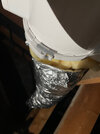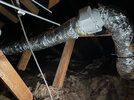- Joined
- 31 Jan 2024
- Messages
- 10
- Reaction score
- 2
- Country

Hello kind people
We recently had an Aventa AV100T installed in the loft by a qualified electrician. The fan is leaking a small amount of water where the removable motor is attached to the main casing with two clips. I have checked very carefully that the water is not leaking from where the ducting is connected to the fan, or that it is condensation forming on the outside of the fan - it is definitely leaking from the two clips. The fan is angled down towards the vent in the outside wall, but also titled on its side by about 70 degrees or so. We have insulation around the ducting and it is held in place with jubilee clips. The water slowly continues dripping the next day. We have the fan speed and over-run time set to max and keep the fan on for a good 30 min or more after a shower anyway, and then still have the over-run after that. I have contacted the manufacturer, but despite repeated follow-ups have so far had no useful reply. Could this simply be a design issue with a fan that has a removable motor and no gasket/seal where it connects with the fan casing? Any ideas?
We recently had an Aventa AV100T installed in the loft by a qualified electrician. The fan is leaking a small amount of water where the removable motor is attached to the main casing with two clips. I have checked very carefully that the water is not leaking from where the ducting is connected to the fan, or that it is condensation forming on the outside of the fan - it is definitely leaking from the two clips. The fan is angled down towards the vent in the outside wall, but also titled on its side by about 70 degrees or so. We have insulation around the ducting and it is held in place with jubilee clips. The water slowly continues dripping the next day. We have the fan speed and over-run time set to max and keep the fan on for a good 30 min or more after a shower anyway, and then still have the over-run after that. I have contacted the manufacturer, but despite repeated follow-ups have so far had no useful reply. Could this simply be a design issue with a fan that has a removable motor and no gasket/seal where it connects with the fan casing? Any ideas?


